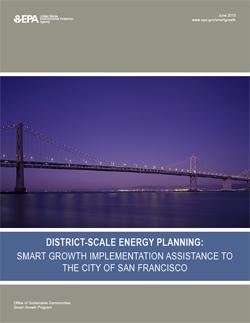District-scale energy systems — which provide heating and cooling from a central utility plant to individual buildings across a neighborhood or development district — can bring benefits beyond simply supplying energy to communities, businesses, and individuals.

District-scale energy systems let developers, property owners, and building managers:
- Save money on energy.
- Have a more reliable system.
- Avoid having to operate and maintain heating and cooling systems in each individual building.
- Allocate more space to tenant uses when they do not have to house their own heating and cooling systems, which increases developable space.
The community as a whole can benefit because these systems can:
- Lower greenhouse gas emissions and other pollution.
- Use more renewable energy sources.
- Encourage new development in existing neighborhoods.
- Help achieve other community goals.
In 2012, the city and county of San Francisco applied to EPA's Smart Growth Implementation Assistance Program for support in encouraging district-scale energy systems in two development areas of downtown San Francisco. The technical assistance project explored how the public sector could facilitate and provide incentives to establish district-scale energy systems that meet local goals.
The report from the project, District-Scale Energy Planning (2015), introduces a four-phase process for district-scale energy planning:
- Initial Assessment, in which the community defines the district's boundaries and goals and determines how future growth and land use changes could affect the system.
- Feasibility, in which the community assesses the technical and commercial viability of a district-scale energy system in the district.
- Project Development, in which responsibility shifts to the energy system developers and users as they begin to design and build the system.
- Operation, Optimization, and Expansion, in which the system operator and other stakeholders, including the community, improve the system's operations and determine whether and how to expand it.
The report includes a technology filtering tool to help municipalities and their stakeholders assess various technologies to determine which can best meet the goals for the system and a parcel evaluation tool to help identify properties that might be well suited to either host the main utility plant for the district system or connect to the system.
San Francisco and other local governments can use this four-phase approach to understand the options for, and benefits of, establishing district-scale energy systems in compact, mixed-use areas — which are particularly well-suited for district-scale energy because they require fewer and shorter pipes to connect users to the system, and energy demand is spread out over the day. The approach can also help communities determine how to capture associated benefits such as energy conservation and resilience, cost efficiency, and support for new investment in existing neighborhoods.
Learn more about how smart growth strategies can help communities reduce greenhouse gas emissions and adapt to climate change.
You will need Adobe Reader to view some of the files on this page. See EPA’s About PDF page to learn more.- District-Scale Energy Planning (PDF)(59 pp, 1 MB, 2015)
